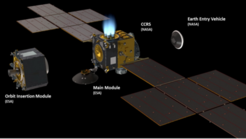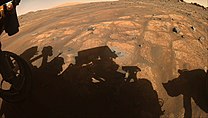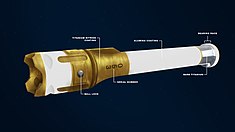NASA-ESA Mars Sample Return: Difference between revisions
No edit summary Tags: Mobile edit Mobile web edit Advanced mobile edit |
No edit summary Tags: Mobile edit Mobile web edit Advanced mobile edit |
||
| Line 1: | Line 1: | ||
The '''NASA-ESA Mars sample-return''' ('''MSR''') mission is a proposed [[Mars Sample Return mission]] to collect martian rock and soil samples in 43 small, cylindrical, pencil-sized, titanium tubes and [[sample-return mission|return them]] to [[Earth]] around 2033.<ref name="NYT-20200728">{{cite news|last=Chang|first=Kenneth|title=Bringing Mars Rocks to Earth: Our Greatest Interplanetary Circus Act – NASA and the European Space Agency plan to toss rocks from one spacecraft to another before the samples finally land on Earth in 2031|url=https://www.nytimes.com/2020/07/28/science/mars-sample-return-mission.html|date=28 July 2020|newspaper=The New York Times|access-date=28 July 2020}}</ref> This ~9 billion USD proposal will allow more extensive analysis than that being done by martian spacecrafts.<ref name=mars>{{Cite web|url=http://www.lpi.usra.edu/decadal/captem/AllanTreimanMars.pdf|title=Treiman, et al. – Groundbreaking Sample Return from Mars: The Next Giant Leap in Understanding the Red Planet}}</ref> |
|||
Although this NASA and ESA's proposal is still in the design stage as of December 2022, the first leg of gathering samples is currently being executed by the ''[[Perseverance (rover)|Perseverance]]'' rover.<ref>{{Cite web |last=mars.nasa.gov |title=Mars Sample Return Campaign |url=https://mars.nasa.gov/msr/ |access-date=2022-06-15 |website=mars.nasa.gov |language=en}}</ref> |
|||
== Mars 2020 mission == |
== Mars 2020 mission == |
||
[[File:Mars 2020 Sample Collection Map showing samples to be left behind at Three Forks Sample Depot.jpg|thumb|Mapping ''Perseverance''{{'s}} samples collected to date (The 10 duplicate samples to be left behind at Three Forks Sample Depot are framed in green colour.)|361x361px]] |
[[File:Mars 2020 Sample Collection Map showing samples to be left behind at Three Forks Sample Depot.jpg|thumb|Mapping ''Perseverance''{{'s}} samples collected to date (The 10 duplicate samples to be left behind at Three Forks Sample Depot are framed in green colour.)|361x361px]] |
||
Revision as of 09:44, 25 December 2022
The NASA-ESA Mars sample-return (MSR) mission is a proposed Mars Sample Return mission to collect martian rock and soil samples in 43 small, cylindrical, pencil-sized, titanium tubes and return them to Earth around 2033.[1] This ~9 billion USD proposal will allow more extensive analysis than that being done by martian spacecrafts.[2]
Although this NASA and ESA's proposal is still in the design stage as of December 2022, the first leg of gathering samples is currently being executed by the Perseverance rover.[3]
Mars 2020 mission
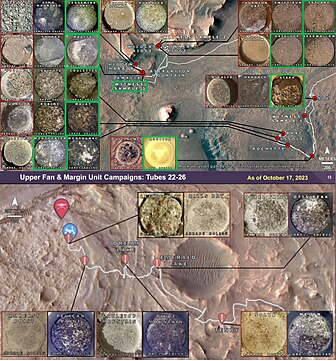

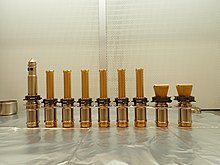
- The pointed one with two windows on left is Regolith drill
- the two shorter ones on left are Abrasion tools
- the rest in center are Rock drills
The Mars 2020 mission landed the Perseverance rover in Jezero crater in February 2021. It collected multiple samples and packed them into cylinders for later return. Jezero appears to be an ancient lakebed, suitable for ground sampling.[9][10][11]
In the beginning of August 2021, Perseverance made its first attempt to collect a ground sample by drilling out a finger-size core of Martian rock.[12] This attempt did not succeed. A drill hole was produced, as indicated by instrument readings, and documented by a photograph of the drill hole. However, the sample container turned out to be empty, indicating that the rock sampled was not robust enough to produce a solid core.[13]
A second target rock judged to have a better chance to yield a sufficiently robust sample was sampled at the end of August and the beginning of September 2021. After abrading the rock, cleaning away dust by puffs of pressurized nitrogen, and inspecting the resulting rock surface, a hole was drilled on September 1. A rock sample appeared to be in the tube, but it was not immediately placed in a container. A new procedure of inspecting the tube optically was performed.[14] On September 6, the process was completed and the first sample placed in a container.[15]
From December 21, 2022, Perseverance started as campaign to deposit 10 of its collected samples to the backup depot, Three Forks.
List of samples cached
- Sample Tube Status
| Sample Details | |||||||||||||||
|---|---|---|---|---|---|---|---|---|---|---|---|---|---|---|---|
| Sampling Attempt | Date | Tube No. | Seal No. | Ferrule Prefix[note 1] | Ferrule No. | Contents | Sample Name and Image during Caching[note 2] | Sample Depot Deposit Date, Spot and Image | Rock Name | Core Length[note 3] | Estimated Martian Atmosphere Headspace Gas[note 4] | Location | Notes | ||
| 1 | 22 June 2021 (Sol 121) |
SN061 | SN147 | 10464848-7 | SN090[16] | Witness Tube (Empty) |  WB-1 |
N/A | N/A | 2.2 x 10−6 mol | North Séítah Unit[17] | This was taken as a dry-run in preparation for later sampling attempts, and did not aim to sample a rock. During final pre-launch activities, this witness tube was activated (the inner seal was punctured to begin accumulation) and placed in the Bit Carousel. This tube will therefore have accumulated contaminants for the entire duration of exposure from a few months before launch through cruise and EDL until it was sealed on the surface of Mars. Given its long exposure, it is likely that the inner surfaces of WB1 will be saturated with organic contaminants, i.e., they will be in adsorption equilibrium with theirimmediate surroundings in the rover (and or the entire spacecraft prior to landing). WB1 is therefore expected to have higher concentrations of contaminants, and potentially different contaminants, than the sample tubes. | |||
| 2 | 6 August 2021 (Sol 165) |
SN233 | SN025 | 10464848-7 | SN062 | Atmospheric Gas |  Roubion (failed attempt of caching rock sample) |
Roubion 18°25′40″N 77°27′06″E / 18.42767°N 77.45167°E |
N/A | 4.9x10−6 mol | Polygon Valley, Cratered Floor Fractured Rough Unit[18] | Attempted to sample the rock but did not succeed, as they didn't reach the bit carousel and the caching system stored and sealed an empty tube. However, in this process, it collected atmospheric samples. | |||
| 3 | 6 September 2021 (Sol 195) |
SN266 | SN170 | 10464848-6 | SN099[19] | Basalt (or possibly basaltic sandstone) Rock Sample |  Montdenier |
Rochette 18°25′51″N 77°26′40″E / 18.43074°N 77.44433°E |
5.98 cm (2.35 in) | 1.2x10−6 mol | Arturby Ridge, Citadelle, South Séítah Unit | Successful sample.[20][21][22] | |||
| 4 | 8 September 2021 (Sol 197) |
SN267 | SN170 | 10464848-6 | SN074 |
Basalt (or possibly basaltic sandstone) Rock Sample |  Montagnac |
Rochette 18°25′51″N 77°26′40″E / 18.43074°N 77.44433°E |
6.14 cm (2.42 in) | 1.3x10−6 mol | Arturby Ridge, Citadelle, South Séítah Unit | Sampled from same rock as previous sample. | |||
| 5 | 15 November 2021 (Sol 263) |
SN246 | SN194 | 10464848-5 | SN107[24] | Olivine cumulate Rock Sample | 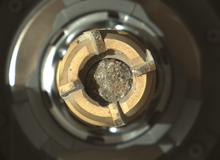 Salette |
Brac 18°26′02″N 77°26′35″E / 18.43398°N 77.44305°E |
6.28 cm (2.47 in) | 1.1 x10−6 mol | Brac Outcrop, South Séítah Unit | ||||
| 6 | 24 November 2021 (Sol 272) |
SN284 | SN219 | 10464848-6 | SN189[24] | Olivine cumulate Rock Sample |  Coulettes |
Brac 18°26′02″N 77°26′35″E / 18.43398°N 77.44305°E |
3.30 cm (1.30 in) | 2.5 x10−6 mol | Brac Outcrop, South Séítah Unit | ||||
| 7 | 22 December 2021 (Sol 299) |
SN206 | SN184 | 10464848-7 | SN064 | Olivine cumulate Rock Sample |  Robine |
Issole 18°25′58″N 77°26′29″E / 18.43264°N 77.44134°E |
6.08 cm (2.39 in) | 1.0 x10−6 mol | Issole, South Séítah Unit | ||||
| 8 | 29 December 2021 (Sol 307) |
SN261 | SN053 | 10464848-6 | SN062 | Olivine cumulate Rock Sample |  Pauls (Abandoned sample from this site due to Core Bit Dropoff.) |
 21 December 2022 (Sol 653) at Three Forks Sample Spot "1" |
Issole 18°25′58″N 77°26′29″E / 18.43264°N 77.44134°E |
N/A | N/A | Issole, South Séítah Unit | Pebble-sized debris from the first sample fell into the bit carousel during transfer of the coring bit, which blocked the successful caching of the sample.[25] It was decided to abandon this sample and do a second sampling attempt again. Subsequent tests and measures cleared remaining samples in tube and debris in caching system[26][27] The tube was reused for second sample attempt, which was successful.
It was the first sample tube to be deposited at a Sample Depot (in this case the depot is Three Forks).[28] | ||
| 9 | 31 January 2022 (Sol 338) |
 Malay (During Caching) |
3.07 cm (1.21 in) | 2.7 x10−6 mol | |||||||||||
| 10 | 7 March 2022 (Sol 372) |
SN262 | SN172 | 10464848-6 | SN129 | Basaltic Andesite Rock Sample |  Ha'ahóni (aka "Hahonih") |
Sid 18°27′09″N 77°26′38″E / 18.45242°N 77.44386°E |
6.50 cm (2.56 in) | 0.98 x10−6mol | Ch’ał outcrop(100 m (330 ft) east of Octavia E. Butler Landing), Séítah Unit | ||||
| 11 | 13 March 2022 (Sol 378) |
SN202 | SN168 | no Cachecam images | SN074 | Basaltic Andesite Rock Sample |  Atsá (aka "Atsah") |
Sid 18°27′09″N 77°26′38″E / 18.45242°N 77.44386°E |
6.00 cm (2.36 in) | 1.3 x10−6 mol | Ch’ał outcrop(100 m (330 ft) east of Octavia E. Butler Landing), Séítah Unit | ||||
| 12 | 7 July 2022 (Sol 491) |
SN188 | 10464848-4 | SN101 | Sedimentary Rock Sample |  Swift Run |
Skinner Ridge 18°24′22″N 77°27′32″E / 18.40617°N 77.45893°E |
6.69 cm (2.63 in) | Skinner Ridge, Delta Front | First Deltaic and First sedimentary sample cached by Perseverance. | |||||
| 13 | 12 July 2022 (Sol 496) |
SN192 | 10464848-6 | SN068 | Sedimentary Rock Sample |  Skyland |
Skinner Ridge 18°24′22″N 77°27′32″E / 18.40617°N 77.45893°E |
5.85 cm (2.30 in) | Skinner Ridge, Delta Front | ||||||
| 14 | 16 July 2022 (Sol 499) |
SN205 | SN110 | 10464848-6 | SN170 | Witness Tube (Empty) |  N/A |
N/A | N/A | Hogwallow Flats,[29] Delta Front | This maybe done to clean out any leftover debris during the previous sampling attempts. | ||||
| 15 | 27 July 2022 (Sol 510) |
SN172 | 10464848-7 | SN099 | Sedimentary Rock Sample |  Hazeltop |
Wildcat Ridge 18°24′21″N 77°27′31″E / 18.40589°N 77.45863°E |
5.97 cm (2.35 in) | Wildcat Ridge, Delta Front | ||||||
| 16 | 3 August 2022 (Sol 517) |
SN259 | SN177 | 10464848-5 | SN110 | Sedimentary Rock Sample |  Bearwallow |
Wildcat Ridge 18°24′21″N 77°27′31″E / 18.40589°N 77.45863°E |
6.24 cm (2.46 in) | Wildcat Ridge, Delta Front | |||||
| 17 | 2 October 2022 (Sol 575) |
SN264 | 10464848-5 | SN085 |  Shuyak |
Amalik outcrop 77°24′05″N 18°27′03″E / 77.40144°N 18.45073°E |
5.55 cm (2.19 in) | Amalik outcrop, Delta Front | |||||||
| 18 | 6 October 2022 (Sol 579) - 16 November 2022 (Sol 589) |
SN184 | SN587 | 10464848-4 | SN030 | Sedimentary rock sample |  Mageik |
 23 December 2022 (Sol 655) at Three Forks Sample Spot "2" |
Amalik outcrop 77°24′05″N 18°27′03″E / 77.40144°N 18.45073°E |
7.36 cm (2.90 in) | Amalik outcrop, Delta Front | The anomaly first appeared on Oct. 5 after the successful coring of the mission's 14th sample, called “Mageik,” when the seal assigned to cap the rock-core-filled sample tube did not release as expected from its dispenser.
The process of sealing a sample happens in the rover's Sampling and Caching System. During sealing, a small robotic arm moves the rock-core-filled tube to one of seven dispensers and presses its open end against a waiting seal. On the 17 previous occasions when a sample tube had been sealed during the mission, the seal was pressed fully into the tube. That allowed the seal to be extracted from the dispenser and the arm to move the seal-tube combination to a different station where they are pressed together, creating a hermetic seal. However, when the sample handling system attempted to dispense a seal in the tube of the Mageik sample, the seal encountered too much resistance and did not come free. The sampling system automatically detected the lack of seal and stored the unsealed tube safely so the tube and sample hardware remain in a stable configuration. One of the possible causes of the seal's nondeployment may be that Martian dust adhered to a location on the tube's interior surface where the dust could impede successful coupling and extraction. To ensure a hermetic seal, the tolerances between tube and seal are, by necessity, extremely small: 0.00008 inches (0.002 mm). The rover's CacheCam captured images showing light deposits of dust on the tube's lip, but the camera's imaging capabilities along the tube's inner surface are quite limited. Sealing which was tried again and again with finally completing it on on 16 November 2022 (Sol 589) successfully.[30] | |||
| 19 | 14 October 2022 (Sol 586) |
SN188 | SN153 | 10464848-5 | SN073 | Witness Tube (Empty) |  N/A |
N/A | N/A | Amalik outcrop, Delta Front | The witness tubes do not collect samples but are opened near the sampling location to "witness" the martian environment. The witness tubes go through the motions of sample collection without collecting rock or soil samples and are sealed and cached like martian samples. Witness tubes aim to ensure that any potential Earth contaminants are detected during sample collection. This is to provide the validity of the samples once returned to Earth for analysis. The witness tube was successfully sealed on Sol 586 (October 14, 2022) and placed into storage on Sol 591 (October 19, 2022).[31] | ||||
| 20 | 24 November 2022 (Sol 627) - 29 November 2022 (Sol 632) |
SN242 | SN151 | 10464848-5 | SN113 | Sedimentary Rock Sample |  Kukaklek |
Hidden Harbor | Hidden Harbor, Delta Front | First Sample from an abrasion patch, abraded earlier on the rock. It was sampled on 29 November 2022 (Sol 632) | |||||
| 21 | 2 December 2022 (Sol 635) |
10464848-5 | SN-063 | Regolith Sand Sample, likely containing mixed sedimentary and igneous grains |  Atmo Mountain |
Observation Mountain | Observation Mountain, Delta Front | First Regolith Sample. | |||||||
| 22 | 7 November 2022 (Sol 640) |
SN191 | 10464848-6 | SN-106 | Regolith Sand Sample, likely containing mixed sedimentary and igneous grains |  Crosswind Lake |
Observation Mountain | Observation Mountain, Delta Front | |||||||
| Sample and Depot Overview | Type Of Cached Samples | Drilled Holes | Sample Depot at Three Forks | ||||||||||||
|
Samples Tubes Cached (49%) 43
21
Samples Tubes Left At Three Forks Sample Depot (20%) 10
2
|
|
 | |||||||||||||
| Sources:[32][33][34][35] | |||||||||||||||
Three Forks Sample Depot
After nearly a martian year of NASA's Perseverance Mars rover's science and sample caching operations for MSR campaign, the rover will now deposit first of ten samples that it has cached from beginning as NASA aims to eventually return them to Earth starting from 19 December 2022. The depot will serve as a backup if Perseverance cannot deliver its samples. Perseverance will deposit the samples at a relatively flat terrain known as Three Forks so that NASA and ESA could recover them in its successive missions in the MSR campaign. It is even selected as the landing spot for the Sample Retrieval Lander. It is a relatively benign place. It is as flat and smooth as a table top.

Perseverance's complex Sampling and Caching System takes almost an hour to retrieve the metal tube from inside the rover's belly, view it one last time with its internal Cachecam, and drop the sample ~0.89 m (2 ft 11 in) onto a carefully selected patch of Martian surface.[28]
The tubes will not be piled up at a single spot. Instead, each tube-drop location will have an “area of operation” ~5.5 m (18 ft) in diameter. To that end, the tubes will be deposited on the surface in an intricate zigzag pattern of 10 spots for 10 tubes, with each sample ~5 m (16 ft) to ~15 m (49 ft) apart from one another near the proposed Sample retrieval lander's landing site. There are various reasons for this plan, biggest for placing them far apart being that is that sample recovery helicopters because they are designed to interact with only one tube at a time. Alongside, they will perform takeoffs and landings, and driving in that spot. To ensure a helicopter could retrieve samples without any problem, the plan to be executed properly and would span over more than two months.
Before and after Perseverance drops each tube, mission controllers will review a multitude of images from the rover's SHERLOCK Watson camera. Images by the SHERLOC WATSON camera are also used to check for surety that the tube had not rolled into the path of the rover's wheels. They also look to ensure the tube had not landed in such a way that it was standing on its end (each tube has a flat end piece called a “glove” to make it easier to be picked up by future missions). That occurred less than 5% of the time during testing with Perseverance's Earthly twin OPTIMISM in JPL's Mars Yard. In case it does happen on Mars, the mission has written a series of commands for Perseverance to carefully knock the tube over with part of the turret at the end of its robotic arm.

These SHERLOCK Watson camera images will also give the Mars Sample Return team the precise data necessary to locate the tubes in the event of the samples becoming covered by dust or sand before they are collected.Mars does get windy, but not like on Earth. But the atmosphere on Mars is 100 times less dense than that of Earth’s atmosphere. So winds around here can pick up speed (fastest are Dust devils), but they don’t pick up a lot of dust particles. Martian wind can certainly lift fine dust and leave it on surfaces. But even if significant dust is accumulated these images and depositing pattern will help to recover them back.[36] Even a lucky encounter with a dust devil can even rover dust over the samples as in case with the solar panels of Spirit rover and opportunity rover.
Once this whole task of depositing all the 10 samples is completed, Perseverance will carry on with its mission, traversing to the Crater floor and scaling Delta's summit. The rover be traversing along the edge of the crater and probably, caching more tubes then whilst following the plan of taking single sample at one rock. Till now, several pairs of samples were taken and one samples from pair will be placed at the depot and the other pair will stay on board the rover.[37][38]
NASA–ESA concept
The NASA-ESA plan is to return samples using three missions: a sample collection mission (Perseverance), a sample retrieval mission (Sample Retrieval Lander + Mars ascent vehicle + Sample Transfer arm + 2 Ingenuity class helicopters), and a return mission (Earth Return Orbiter).[39][40][41] The mission hopes to resolve the question of whether Mars once harbored life.
Sample collection
The Mars 2020 mission landed the Perseverance rover, which is storing samples to be returned to Earth later. After consideration, it was decided that given Perseverance's expected longevity, it will be the primary means of transporting samples to Sample Retrieval Lander (SRL).

Sample retrieval

(Artwork; 27 July 2022)
The sample retrieval mission involves launching a sample return lander in 2028 with the Mars Ascent Vehicle and two Ingenuity class sample recovery helicopters, both of which will be collecting the samples with a tiny robotic arm as a backup for Perseverance. The rover and helicopters will transport the samples to the SRL lander. SRL's EAS-built sample transfer arm will be used to extract the samples and load them into the Sample Return Capsule in the Ascent Vehicle.[39] It is planned to land near the Octavia E. Butler Landing site in 2029.
Mars Ascent Vehicle (MAV)
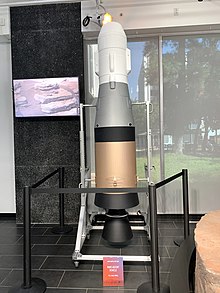

MAV is a 3 m (9.8 ft) long, two-stage, solid-fueled rocket that will deliver the collected samples from the surface of Mars to the Earth Return Orbiter. Early in 2022, Lockheed Martin was awarded a contract to partner with NASA's Marshall Space Flight Center in developing the MAV.[43] It is planned to be catapulted into the air just before it ignites, at a rate of 16 feet (5 meters) per second, to remove the odds of wrong liftoff like slipping or tilting of SRL under rocket's shear weight and exhaust at liftoff. This Vertically Ejected Controlled Tip-off Release (VECTOR) system adds a slight rotation during launch, pitching the rocket up and away from the surface.[44] MAV would enter a 380 km orbit.[45] It will remain stowed inside a cylinder on the SRL and will have a thermal protective coating. The rocket's first stage (SRM-1) would be run by a single modified STAR-20 engine burning for 70 seconds, while the second stage (SRM-2) would have a single modified STAR-15G engine burning for another 25 seconds.[46] They would be separated by a coast phase, after which the sample container would be released in orbit. As of early 2022, the second stage is planned to be spin-stabilized to save weight in lieu of active guidance, while the Mars samples will result in an unknown payload mass distribution.[45]
MAV is scheduled to be launched in 2028 on board the SRL lander.[39]
Sample return
Earth Return Orbiter (ERO)
ERO is an ESA-developed spacecraft.[47][48] It includes the NASA-built Capture and Containment and Return System to rendezvous with the samples delivered by MAV in low Mars orbit (LMO). ERO orbiter is planned to weigh ~6,000 kg (13,000 lb) and has solar arrays that have a wingspan of more than 40 m (130 ft) (these are some of the largest solar panels ever launched into space).
ERO is scheduled to launch on an Ariane 64 rocket[49] in 2027 and arrive at Mars in 2028,[39] using ion propulsion and a separate propulsion element to gradually reach the proper orbit and then rendezvous with the orbiting sample. The MAV's second stage will have a radio beacon that will give controllers the information they need to get the ESA Earth Return Orbiter close enough to the Orbiting Sample to see it through reflective light and capture it for return to earth. The orbiter will retrieve and seal the canisters in orbit and use a NASA-built robotic arm to place the sealed container into an Earth-entry capsule. It will raise its orbit, release the propulsion element, and return to Earth during the 2033 Mars-to-Earth transfer window.
Earth Entry Vehicle (EEV)
The Capture/Containment and Return System (CCRS) would stow the sample in the EEV. EEV would return to Earth and land passively, without a parachute. The desert sand at the Utah Test and Training Range and shock absorbing materials in the vehicle were planned to protect the samples from impact forces.[50][51][48] EEV is scheduled to land on Earth in 2033.[52]
NASA–ESA gallery
- Potential sample-return landing site (14 April 2022)
- ^ Chang, Kenneth (28 July 2020). "Bringing Mars Rocks to Earth: Our Greatest Interplanetary Circus Act – NASA and the European Space Agency plan to toss rocks from one spacecraft to another before the samples finally land on Earth in 2031". The New York Times. Retrieved 28 July 2020.
- ^ "Treiman, et al. – Groundbreaking Sample Return from Mars: The Next Giant Leap in Understanding the Red Planet" (PDF).
- ^ mars.nasa.gov. "Mars Sample Return Campaign". mars.nasa.gov. Retrieved 2022-06-15.
- ^ mars.nasa.gov. "Perseverance Rover Mars Rock Samples". NASA Mars Exploration. Retrieved 2023-12-25.
- ^ "Nobody Tell Elmo About Issole". nasa.gov. Retrieved February 11, 2022.
- ^ mars.nasa.gov. "NASA's Perseverance Plans Next Sample Attempt". NASA’s Mars Exploration Program. Retrieved August 27, 2021.
- ^ "Sample Caching Dry Run, 1st sample tube cached". Twitter. Retrieved August 27, 2021.
- ^ mars.nasa.gov. "Perseverance Sample Tube 266". NASA’s Mars Exploration Program. Retrieved September 9, 2021.
- ^ "Welcome to 'Octavia E. Butler Landing'". NASA. 5 March 2021. Retrieved 5 March 2021.
- ^ Voosen, Paul (July 31, 2021). "Mars rover's sampling campaign begins". Science. 373 (6554). AAAS: 477. Bibcode:2021Sci...373..477V. doi:10.1126/science.373.6554.477. PMID 34326215. S2CID 236514399. Retrieved August 1, 2021.
- ^ mars.nasa.gov. "On the Eve of Perseverance's First Sample". mars.nasa.gov. Retrieved 2021-08-12.
- ^ Voosem, Paul (June 21, 2021). "NASA's Perseverance rover to drill first samples of martian rock". Science. AAAS. Retrieved August 1, 2021.
- ^ mars.nasa.gov. "Assessing Perseverance's First Sample Attempt". mars.nasa.gov. Retrieved 2021-08-12.
- ^ mars.nasa.gov (2 September 2021). "Nasa's perseverance rover successfully cores its first rock". mars.nasa.gov. Retrieved 2021-09-10.
- ^ mars.nasa.gov (6 September 2021). "Nasa's perseverance rover collects first Mars rock sample". mars.nasa.gov. Retrieved 2021-09-10.
- ^ @NASAPersevere (July 8, 2021). "Lots of first-time activities before I start drilling. I recently ran one sample tube through inspection, sealing a…" (Tweet). Retrieved 2021-08-27 – via Twitter.
- ^ "Witness Tube in Perseverance Sample Caching System". NASA Jet Propulsion Laboratory (JPL). Retrieved 2021-09-09.
- ^ mars.nasa.gov. "Perseverance's Drive to Citadelle". NASA’s Mars Exploration Program. Retrieved 2021-09-06.
- ^ mars.nasa.gov. "Kicking off the Sampling Sol Path at Citadelle". mars.nasa.gov. Retrieved 2021-09-06.
- ^ Fox, Karen; Johnson, Alana; Agle, AG (2 September 2021). "NASA's Perseverance Rover Successfully Cores Its First Rock". NASA. Retrieved 3 September 2021.
- ^ Chang, Kenneth (3 September 2021). "On Mars, NASA's Perseverance Rover Drilled the Rocks It Came For – After an earlier drilling attempt failed to collect anything, the rover appeared to gather its first sample. But mission managers need to take another look before sealing the tube". The New York Times. Retrieved 3 September 2021.
- ^ Chang, Kenneth (7 September 2021). "NASA's Perseverance Rover Stashes First Mars Rock Sample – The rock, sealed in a tube, is the first of many the robotic explorer will collect to one day send back to Earth for scientists to study". The New York Times. Retrieved 8 September 2021.
- ^ mars.nasa.gov. "A Historic Moment – Perseverance Collects, Seals, and Stores its First Two Rock Samples". mars.nasa.gov. Retrieved 2021-12-18.
- ^ a b @NASAPersevere (November 24, 2021). "A rock so nice, I sampled it twice! Just capped and sealed my fifth sample tube, with another piece from this inter…" (Tweet). Retrieved 2021-12-18 – via Twitter.
- ^ mars.nasa.gov. "Assessing Perseverance's Seventh Sample Collection". mars.nasa.gov. Retrieved 2022-03-08.
- ^ mars.nasa.gov. "Pebbles Before Mountains". mars.nasa.gov. Retrieved 2022-03-08.
- ^ mars.nasa.gov. "Ejecting Mars' Pebbles". mars.nasa.gov. Retrieved 2022-03-08.
- ^ a b mars.nasa.gov. "NASA's Perseverance Rover Deposits First Sample on Mars Surface". NASA Mars Exploration. Retrieved 2022-12-22.
 This article incorporates text from this source, which is in the public domain.
This article incorporates text from this source, which is in the public domain.
- ^ @PaulHammond51 (August 7, 2022). "@chiragp87233561 Be careful with names. The witness tube was not sampled at 'Skinner Ridge'. Skinner Ridge is the n…" (Tweet). Retrieved November 4, 2022 – via Twitter.
- ^ mars.nasa.gov. "Sealing Sample 14 - NASA". mars.nasa.gov. Retrieved 2022-11-24.
- ^ University, Stephanie Connell, SuperCam, PhD Student at Purdue. "Perseverance Activities at Amalik Outcrop - NASA". mars.nasa.gov. Retrieved 2022-11-24.
{{cite web}}: CS1 maint: multiple names: authors list (link) - ^ mars.nasa.gov. "Perseverance Rover Mars Rock Samples". NASA Mars Exploration. Retrieved 2022-06-15.
- ^ "MARS 2020 INITIAL REPORTS Crater Floor Campaign" (PDF).
- ^ "Mars 2020 Returned Sample Science Archive". pds-geosciences.wustl.edu. Retrieved 2022-10-06.
- ^ "I had a list I was working on, combined it with the NASA website chart". Twitter. Retrieved 2022-10-24.
- ^ https://twitter.com/NASAPersevere/status/1606429871152197632?s=20&t=6-jcs02RMPnBSBK4xpKCBA
- ^ Foust, Jeff (2022-12-18). "Perseverance prepares to deposit Mars sample cache". SpaceNews. Retrieved 2022-12-22.
- ^ mars.nasa.gov. "NASA's Perseverance Rover to Begin Building Martian Sample Depot". NASA Mars Exploration. Retrieved 2022-12-22.
- ^ a b c d Foust, Jeff (27 March 2022). "NASA to delay Mars Sample Return, switch to dual-lander approach". SpaceNews. Retrieved 28 March 2022.
- ^ "Future Planetary Exploration: New Mars Sample Return Plan". 8 December 2009.
- ^ "Mars sample return". www.esa.int. Retrieved 2022-01-03.
- ^ Chang, Kenneth (27 July 2022). "NASA Will Send More Helicopters to Mars - Instead of sending another rover to help retrieve rock and dirt samples from the red planet and bring them to Earth, the agency will provide the helicopters as a backup option". The New York Times. Retrieved 28 July 2022.
- ^ "NASA Selects Developer for Rocket to Retrieve First Samples from Mars". NASA Press Release 22-015, Feb 7 2022. 7 February 2022. Retrieved 2 July 2022.
- ^ "NASA Begins Testing Robotics to Bring First Samples Back From Mars". NASA Jet Propulsion Laboratory (JPL). December 13, 2021. Retrieved 2022-08-02.
- ^ a b Yaghoubi, Darius; Maynor, Shawn. "Integrated Design Results for the MSR SRC Mars Ascent Vehicle" (PDF). NASA Technical Reports Server. Retrieved 26 April 2022.
- ^ "identify this object - What are these two little valve stem-like projections from the Northrop Grumman STAR 15G upper stage rocket motor? Why doesn't the STAR 20 have them?". Space Exploration Stack Exchange. Retrieved 2022-12-22.
- ^ "Airbus to bring first Mars samples to Earth: ESA contract award | Airbus". www.airbus.com. 28 October 2021. Retrieved 2021-12-14.
- ^ a b Cite error: The named reference
Planetary Decadal 2010was invoked but never defined (see the help page). - ^ "Earth Return Orbiter's first step to Mars". Airbus (Press release). 15 June 2021. Retrieved 28 March 2022.
- ^ Kellas, Sotiris (March 2017). "Passive earth entry vehicle landing test". 2017 IEEE Aerospace Conference. Big Sky, MT, USA: IEEE: 1–10. doi:10.1109/AERO.2017.7943744. hdl:2060/20170002221. ISBN 978-1-5090-1613-6. S2CID 24286971.
- ^ Cite error: The named reference
Denver Museumwas invoked but never defined (see the help page). - ^ Gebhardt, Chris; Barker, Nathan (2021-06-04). "Mars Ascent Vehicle from Northrop Grumman takes shape for Mars Sample Return mission". NASASpaceFlight.com. Retrieved 2021-08-27.
- ^ Kahn, Amina (10 February 2020). "NASA gives JPL green light for mission to bring a piece of Mars back to Earth". Los Angeles Times. Retrieved 11 February 2020.
- ^ "Mission to Mars – Mars Sample Return". NASA. 2020. Retrieved 11 February 2020.
 This article incorporates text from this source, which is in the public domain.
This article incorporates text from this source, which is in the public domain.
Cite error: There are <ref group=note> tags on this page, but the references will not show without a {{reflist|group=note}} template (see the help page).






